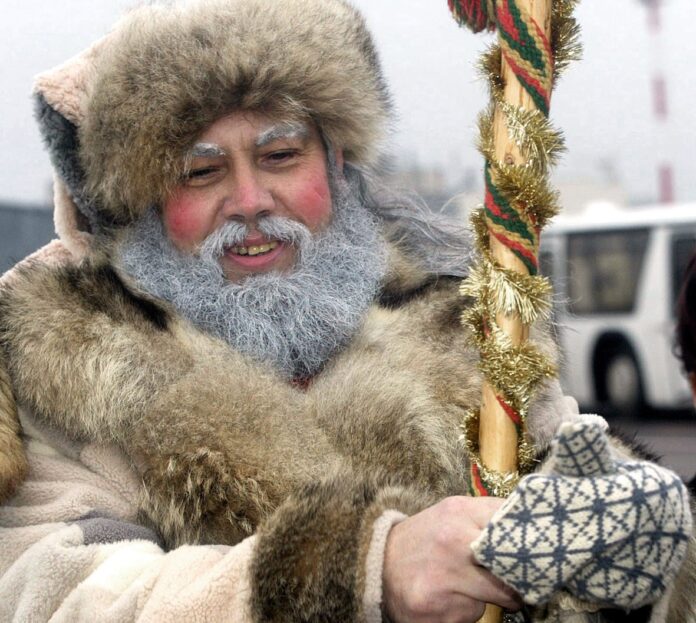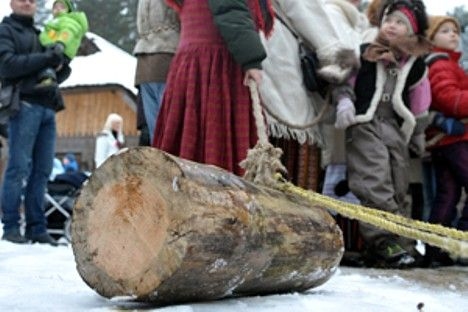
What you may not know…
Most of us know about Lithuanian Christmas Eve traditions. Sharing Christmas wafers, twelve special meatless dishes, the folklore about the magic of that night, the predictions and rituals of respect for the souls of the dead. But Lithuanian Christmas Day traditions have become somewhat lost in time, with inevitable changes and influences from abroad.
In Lithuania, Christmas Day, referred to as the first day of Christmas, was spent at home with family, going out only for early Mass. Toward evening, visitors called “kalėdotojai” might come by, led by Old Man Christmas, who was called “Kalėda”. Ethnologists concur that the Lithuanian Kalėda is not related in any way to the Christian St. Nicholas, who visited children in Western Europe, or with Santa Claus. The Lithuanian Kalėda is a distinct folkloric personality.
Kalėda would be dressed in a fur coat turned inside out, belted with a towel, and sported a flaxen beard. Sometimes he would have a hunch back, and carried a staff and a sack. He would knock on the door with his staff, and introduce himself: “I am Kalėda, I came from another place, where there are hills of flour, rivers of honey, lakes of ale, where it rains candy and snows bagels. I carry a trove of riches – good fortune, harvest and other treasures. Please open the door and don’t chase me back there.”
In folk songs, Kalėda is said to be coming from a faraway place by way of tall mountains and deep valleys on grey horses pulling a new sled, with silken whips and colourful boots, bringing sides of bacon and racks of sausage, bags of nuts, golden cups and silver rings for the girls and wine for the young men.
In Lithuania, Kalėda did not wander alone, but had an entourage of costumed companions. Ethnographic data tells us that the oldest masqueraders were represented animals, and were 12 in number. By the early 20th century, only one costumed person would appear with him, dressed as a crane, a grey horse, a bear, a goat or some strange being.
One expert suggests that both the Christmas and Lenten masqueraders hail from rituals related to the return or rescue of the sun (“saulės vadavimas”, the Northern myth of the sun being captured, then rescued, referring to the winter solstice) and restoration of order in the world for the New Year. In historical sources, the main character in the myth is Kalėda, related to the hammersmith-god Teliavelis who created the sun. (The word “kalti” in Lithuanian means “to hammer”.)
Visits by Christmas masqueraders, called “kalėdojimas”, may have their origin in pre-Christian rituals that included the visitations of wizards. Kalėda did not distribute physical gifts. He would bless a home to ensure harmony and good fortune for the coming year. His words were magical. To ensure their efficacy, the corners of the house would be sprinkled with oats, as a form of offering to household gods and an imitation of sowing. Kalėda himself would receive gifts for visiting and blessing the house. His entourage would be given food and other good things.

As they walked through the neighbourhood, Christmas masqueraders would haul a block of wood, a stump or a log. This tradition survived the longest in Žemaitija (Samogitia). They would sing and use sticks to beat the block (called a “blukis”), afterwards joyfully burning it as a symbol of darkness and evil.
In current thinking, the role of Old Man Christmas is to make children happy. His attention to children was a feature of the old Lithuanian traditions as well. Visiting a household, Kalėda would give the children nuts and bagels. In Aukštaitija (the Highlands of Lithuania), Kalėda would lead a procession of children bleating like sheep at neighbours’ windows to ensure healthy lambs for the coming year. In other places, Kalėda and the children would visit each house to amuse the smallest children, who couldn’t yet join in.
The visits were important for youth and adults as well, with various rituals meant to help villagers find their mates. Christmastime was the beginning of “social life” – evenings of song, dance and games to bring young people together, a auspicious time for match-making and betrothals. “Kalėdojimas” was equally significant for promoting community spirit and in Žemaitija in particular, Christmas was a time to visit and help the sick and the old.
Ethnologists have written about a Christmastime game at events called “kalėduškos”. The evening would begin with a young man sitting on a chair in the middle of the room. He would chant: Kepu, kepu genelį, ne seną, o jauną, margaplunksnelį. “I’m cooking a woodpecker, not an old one, but a young, many-coloured one”. Someone would ask: “Will you cook him long?” and the young man, choosing the girl he was interested in, would answer: “Just until Marytė kisses me.” Marytė would come up and kiss him, then the two would sit down at the table together to eat and dance together all evening. Another day the “kalėduška” would take place somewhere else, and the pairs would change again.
For Lithuanians, Christmas is a three-day event – counting the 25th, 26th and 27th of December, but the “season” of social events and festivities continues until the Epiphany, or Three Kings, on January 6.





























